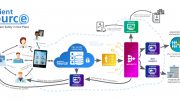In this 3-part series, Richard Baylor, COO at St. Vincent’s Consulting and former Cerner (now Oracle) executive, and Paul Charnley, Luminary advisor and former NHS CIO of the Year share their insights on building strong EPR vendor-trust relationships.
Setting the Stage for EPR Vendor-NHS Trust Success
Richard Baylor, COO at St. Vincent’s Consulting and former Cerner (now Oracle) executive, and Paul Charnley, Luminary advisor and former NHS CIO of the Year share their insights on building strong EPR vendor-trust relationships. Beginning with the crucial topics of early engagement, strategic alignment, and moving beyond contractual agreements to develop lasting partnerships.
Early engagement, strategic alignment
From a vendor’s perspective, Richard emphasises that the foundation of a successful relationship lies in early engagement and meticulous procurement processes. He likens the procurement phase to ‘dating’, where compatibility and shared values are established before formalising commitments akin to a ‘marriage’ through contractual agreements.
Richard underscores the importance of ensuring that client stakeholders are fully involved in these initial stages. Often, trusts engage consultancies to manage business case and procurement activities, which can lead to key stakeholders not being fully involved until later stages. Including these stakeholders early on ensures that their needs and perspectives are integrated from the outset.
According to Richard, strategic alignment on high-order objectives, such as innovation, is pivotal. Aligning the EPR supplier’s innovation goals with the NHS trust’s digital leadership aspirations fosters synergy and mutual growth. Clear and consistent communication from the outset ensures alignment and prevents misunderstandings.
From the NHS trust perspective, Paul highlights the importance of defining success criteria early to integrate EPR systems seamlessly into healthcare delivery. For trusts, success extends beyond technical functionalities; it encompasses selecting a partner who understands and supports broader organisational goals.
Paul also points out the necessity of having the supplier’s delivery and service personnel involved early in the process, rather than only interacting with the sales team. This approach prevents the scenario where the client and the supplier’s long-term project team only meet at the ‘ceremony’ of contract signature, akin to an arranged marriage.
Early meetings between the client and supplier delivery/service personnel fosters mutual understanding and trust from the beginning. Strategic alignment, as Paul highlights, is achieved through shared definitions of success and mutual understanding, facilitating trust-based partnerships that enhance patient care.
Beyond contractual agreements
Both perspectives converge on the significance of fostering partnerships that transcend mere contractual obligations. Richard stresses the need for sustained engagement and organisational connectivity within NHS trusts to prevent relationships from becoming transient.
He highlights the importance of differentiating between personal, professional, and organisational relationships. While personal relationships between key individuals can be crucial, long-term success depends on nurturing all three types of relationships. Relying too heavily on a few personalities can create challenges if key team members depart.
Therefore, aligning corporate values during procurement ensures long-term compatibility and minimises potential conflicts. Richard emphasises the significance of proactive efforts and sustained involvement across all levels of the organisation, aiming to foster enduring connections that bolster mutual trust and collaboration, even amidst staff changes.
Paul highlights the value of building authentic relationships grounded in open communication and mutual support. He identifies shared values like integrity and patient-centred care as fundamental to establishing trust and fostering collaboration.
Transparency and alignment on strategic objectives from the outset are crucial for nurturing resilient partnerships that can adapt and flourish in dynamic healthcare environments. Additionally, Paul advocates for EPR vendors to invest in supporting NHS trusts beyond contractual obligations, citing long-term benefits derived from such proactive engagement.
Key Takeaways:
- Involve key client stakeholders early in the procurement process to ensure their needs are integrated from the start.
- Align the vendor’s innovation goals with the NHS trust’s broader objectives, especially around digital leadership, to promote mutual growth.
- Establish clear and consistent communication from the outset to ensure alignment and prevent misunderstandings.
- Include the vendor’s delivery and service teams early, not just the sales team, to build mutual understanding and trust before the contract is signed.
- Define success criteria early, focusing on both technical and broader organisational goals to ensure seamless integration of EPR systems into healthcare delivery.
Cultivate personal, professional, and organisational relationships to ensure long-term success, reducing reliance on key individuals who may leave.





